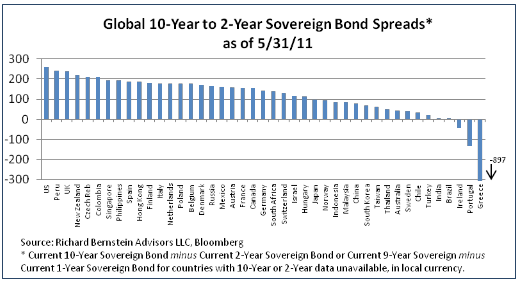In a recent note Richard Bernstein, no longer with Merrill Lynch and running his own shop, Richard Bernstein Advisors, highlighted some recent trends in global yield curves:
“One of our favorite indicators is the slope of the yield curve. Yield curves have historically been very good predictors of future profits growth and of future trends in equity market volatility. Steep curves (i.e., a wide, positive spread between 10-year and 2-year notes) have generally been followed by periods of stronger growth and lower volatility, whereas inverted yield curves (i.e., the 2-year rate is higher than the 10-year rate) have generally been followed by profits recessions (i.e., periods with negative year-over-year trailing EPS growth) and higher volatility.
The United States currently has the steepest yield curve in the world. As Chart 2 shows, the spread between US 10-year and 2-year notes was about 259 basis points at the end of May. Interestingly, this is not only the steepest yield curve in the world at present, but the US yield curve is close to its steepest since the mid-70s (the steepest was the 291 basis-point spread on February 4, 2011).
If history is any guide, the very steep US yield curve argues that current expectations regarding future US corporate profits growth and equity market volatility trends are too bearish. However, some yield curves around the world are starting to suggest increased caution may be warranted.
Chart 2 also reflects that yield curves are inverted or very flat in a number of countries, including some of the BRICs. Most investors are probably not surprised that Greece, Portugal and Ireland currently have the world’s most inverted yield curves, but our guess is that investors have no idea that Brazil’s yield curve is a mere 1 basis point from inversion, or that India’s is only 2 basis points from inversion.”
“Many US investors are very concerned about the Fed’s future monetary policy and the looming end of QE2, but aren’t the least bit aware that yield curves in the BRIC countries might soon invert. This seems critically important to us because history shows well that bull markets typically end not at the beginning of a central bank’s tightening cycle, but rather when the central bank has tightened too much, and inverted yield curves typically indicate that a central bank has tightened too much.
The US currently has the steepest yield curve in the world, and investors are very concerned about the longevity of the US bull market. BRIC yield curves are close to inverting, but investors don’t seem the least bit concerned.
This is a whopping disconnect, in our view, and presents a significant, actionable investment opportunity.”
I am not one to question this analysis, but it’s important to note that a slow-down in the BRIC countries would most certainly spill-over into developed countries. Particularly given the current environment in which developed nations are mired in near persistent recession and largely relying on emerging markets for growth. That said, a developed country such as the USA whose yield curve is quite steep, might outperform, but performance is relative in our global economy. And in this case, relative likely means “better than horrible”.


No comments:
Post a Comment